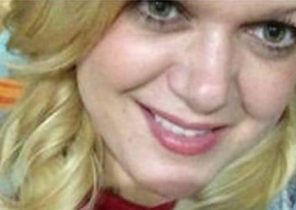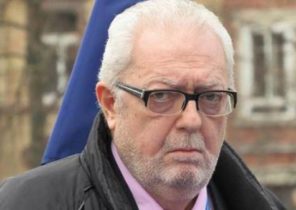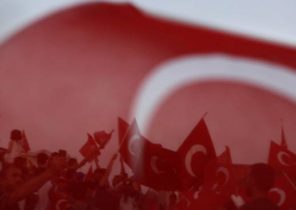
Not far from Kiev, the Rabbi came up with a crazy idea to build a shtetl (the so-called in the nineteenth century, Jewish settlements in Central Europe), to accommodate refugees from war-torn 2014 Donbass.
As in any good Jewish tale, this story featured a number of characters, which we politely call the original. Full the Rabbi with a view of the fervent prophet of the old guard of the synagogue with a quavering voice, joiner-neiada that builds for the community outstanding temple… And like any good Jewish tale, the story begins with a digression into the past 179 years ago, when the Jews were more or less quiet life in the vast expanses of Eastern Europe and tsarist Russia.
At the end of the days of the Chernobyl Rabbi Mordechai Tversky made a decision: he wanted to meet death not in Kiev, where he then lived, and in place of his own choosing. Long search was not necessary. 30 kilometers West of Kiev, he found an overgrown hill near the river Irpin in a sufficient distance from their homes, primarily in the neighboring village Hnativka to “no sound of impure bells did not disturb my eternal peace.” Whatever it was, he spent a short time alone. His small mausoleum became the center of the cemetery surrounding steclov. A special way of life and craftsmanship, thriving culture and Yiddish, have all made almost entirely inhabited by Jews from the village centre and symbol of Jewish culture in Eastern Europe. In the first half of the nineteenth century 80% of the Jews of the region lived in the shtetl.
Special culture
About this life told dozens of people. One of them, Sholem Aleichem, was born 22 years after the death of Rabbi Tversky in a nearby village that does not change anything in our history. Shtetl in “Tevye the milkman” is called Anatevka that is a clear allusion to the Hnativka. The product has gained popularity after the transcriptions in the musical “Fiddler on the roof”, where the viewer is presented a series of symbolic characters of the shtetl: the poor artisans and rich merchants, young women and professional matchmakers, rabbis-and the conservatives flirting with Marxism students. All this against the background of more or less complacently a Christian-minded peasants.
The story ends with a little unofficial demonstration, according to a Russian official, that is, the mayhem that sweeps Anatevka and forcing its inhabitants to leave. Such bloody unrest of Christians, which in some cases was carried out with the consent of the tsarist authorities, led to the disappearance of tens of thousands stelow since the late nineteenth century. The remaining did not survive the forced Sovietization, and then came from Europe the Nazi wave. Such is the history of culture steclov in Europe.
It took 180 years. Today from the cemetery of Gnatovka not gone. The villagers were gradually dug up the gravestones and used them as building materials. There was only a mausoleum, Chernobyl Rabbi, where from time to time come pilgrims from Israel, USA and Europe. Anyway, now this place, where he died Mordechai Tversky was born Sholem Aleichem, is of interest for another reason: it builds the first shtetl on European soil since the Second world war.
Anatevka became a fantasy, a bit eccentric Rabbi and the war in the East of Ukraine. With the outbreak of hostilities between the Ukrainian authorities and supported by Russia separatists in the Donbass in 2014, Rabbi Moshe Azman, one of the leaders of the Jewish community of Kiev, was raised by the faithful for aid to refugees-Jews.
Large-scale work
First there was the sanatorium, where since the summer of 2014 has placed about two dozen families, that is about 50 people. Only the conflict is not thought to end, and temporary became permanent. Needed to do something more appropriate for families who did not think to return to war-torn or rebel-held territory. The active, in spite of 50 years of age, Rabbi Azman said the idea to buy a few acres in the vicinity of Kiev. All the way was because he needed the land to transfer religious school at his synagogue: the building in Kiev became the target of increasingly serious legal attacks. In addition, he had the opportunity to realize an old dream: to build a new shtetl and offer its inhabitants a closed life, with a focus on spirituality. “I had the desire to unite past and present — says the Rabbi in his office in his religious school in Anatevka. — In a sense, this tragic war really accelerated the process.”
The operation was very ambitious. First was built a wooden “hotel” to host the first 20 refugee families who had worked together with local businesses. Then came school, the great synagogue (also of wood), the first concrete building… In the future there will be a medical center and more comfortable housing for refugees and Kiev families that decide to move. In his most insane dreams, Rabbi Asman sees the Museum of Jewish history, school of music… and home to 500 residents. Anyway, so far from Kiev there arrived only one family.
Now small closed area Anatevka more like a construction site than in the picturesque village of past times: everywhere mud and scattered equipment. There is no road, but the budget is not enough 100 thousand euros. Money is a constant headache for the Rabbi. Fortunately, the priest has a talent in marketing. He creates for himself the image of a new Tevye to advertise online and attract attention and subsidy of foreign, primarily American Jewish communities. That is why he called the village of Anatevka, not knowing at the time of purchase of the land, there is the mausoleum of Rabbi Tversky. “Accidents do not happen then he smiles. — In Ukraine scattered millions of refugees, but fate brought us here.”
The truth is, when Jacob (he doesn’t want to use your real name, not to create trouble for the rest in the East relatives) fled in the middle of the night from his home in the vicinity of Lugansk, he is not particularly thinking about fate or where it would lead him. The yard was in August 2014, in the Donbass began to drop bombs, and he and his wife Nadia understood that they are in danger from separatists. “We do not hide our Pro-Ukrainian position, because the 70-year-old former stage actor. — While serving in the army in 1968 I was in Prague. In a way, I was also a resident of the “Russian world” of Vladimir Putin, and it’s I didn’t like”. Yakov and Nadia moved in the night under fire across the front line and stopped in the Kiev Studio apartment son. Then they moved to a sanatorium and finally to Anatevka.
Shelter
The pair reflects the characteristics of the region, where there is a strange cultural war. Nadia is not Jewish, and Jacob in Soviet times was focused only on the big holidays. Whatever it was, he did not forget about their Jewish roots, and anti-Semites in any case, we are constantly reminded about them”. Later he became curious and learned Hebrew, in connection with Rabbi Asman asked him to be the guardian of the synagogue. Jacob acknowledges the same undertone that doesn’t feel great faith. “I’m not going to pretend I’m not in a hurry,” he says, heading heavy steps to the door of the synagogue, to open them for the 8-hour morning prayer, which brings together more than five people.
The family remains in Anatevka in the first place because they have nowhere else to go, and what the community is free housing, and a common kitchen for the refugees take turns in preparing all meals. A strong argument for Ukraine, where tens of thousands of people can’t even find a roof over my head.
A few of the villagers — active believers, and some not even Jews. All bear the imprint of the secular ideology of the Soviet Union and Donbass, which is proud of its working and miners ‘ identity. Anyway, such discrepancies between the dreams of the Rabbi and the relative indifference of the people do not create serious tensions. “Rabbi urges us to go to high holiday services, but not more,” says 25-year-old Avenir. Worked before the war in Lugansk young man is not a Jew, but says that more are interested in religion. He has always been familiar with thanks to her 19-year-old wife, Cassandra, who went to the Jewish school of Lugansk. This summer, a young family appeared first shtetle child, little Eva. “We don’t force refugees to go to the synagogue, says Rabbi Asman. — We offer them the openness to spirituality, but every choice still makes himself”. Upon arrival, people just have to sign the original Charter, which undertake to abide by the rules of power, not openly to violate the Sabbath (for example, not to light up before the other residents) and to wear “modest” clothes.
Some embraced it, especially women. “Pride is a sin, but to participate in such a project — an exciting feeling,” says 39-year-old Sonia Semenenko. In Donetsk she rarely went to the synagogue, but has now become a believer, and her children, 10 and 14 years, actively promoted in religious education. The eldest recently celebrated a bar mitzvah, first and last in Anatevka. “In the summer of 2014 we with other families a few weeks hiding in the basement of the Donetsk synagogue bombs, says Sonia. — The fact that the temple became a refuge, deeply shocked me. And then the war separated families, which were scattered around Ukraine, Russia and Israel. It is very important that there is a sense of community”. Sonia with her husband sure when will be completed new buildings, and they save money, then buy an apartment in Anatevka.
Modern shtetl
How to recognize some people, the only problem is boredom. Only a very few managed to find work in Kiev. Sonia sews clothes, but most of the time idle in a small Studio apartment of the family in the hotel. Easier all have 50-year-old carpenter, Sergei. He is not a Jew, but proud of the arch of fine workmanship, which was recently presented to the synagogue. The rest of the time he works in his Studio, which was decorated with miniatures of the ships.
Children go to school. Every morning, 150 of the students come from Kiev in a rented bus to school “mitzvah-613”, modern building with a beautiful classes. Among them 50 children from Kiev and settled in families of Jewish refugees. They are joined by seven children from Anatevka. “Sometimes they have signs of the trauma of the war, they have harder than the rest,” says Khan, the headmistress of the school and wife of Rabbi Asman. The same continues to pave the way forward, like a bulldozer. He is convinced that the refugees will remain in Anatevka regardless of the fate of the still war-torn Donbass, and the Kiev that his congregation will move to the village. His new goal: to achieve from the authorities of the official status of Anatevka. This would allow the residents easier to receive mail and would strengthen Anatevka in the way of a modern shtetl. “The state we especially did not help, but never interfere with what is already done in this [bureaucratic and corrupt] country like Ukraine. We kindly accepted, when we wanted to conduct electricity”.
The appearance of Anatevka says a lot about the Zeitgeist of modern Ukraine. Revolution on the Maidan and the war in the East has pushed the country to think seriously about their identity. In parallel with the glorification of the nationalists, who during the Second world war, cooperated with Nazi Germany to fight the USSR, the country began to remember about the Jewish heritage and to honor the memory of those killed between 1941 and 1945, 1.5 million Jews. Autumn in Kiev with unprecedented solemnity celebrated the 75th anniversary of the events at Babi Yar, where the Nazis in two days killed 34 thousand Jews. The authorities promised to build a new memorial. The ceremony was led by Prime Minister Vladimir Groysman: the appointment of a Jew to such a high position did not cause any anti-Semitic comments. In addition, the Jews join the volunteer battalions of the ultra-nationalist and right-wing movements who are fighting in the Donbas separatists and the Russian army.
“After world war II and the collapse of the Soviet Union, many Jews left, like the Rabbi Asman. — If you now start a new wave (in 2014 left the country of 6 million Jews, and in 2015 — 7 thousand 500), this will not be just a sign of bad luck and tragedy for Ukraine. But if we show that we Jews are unable to build something, it will mean that all of Ukraine can build the future.”







